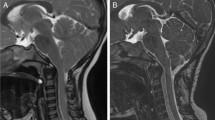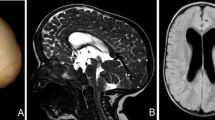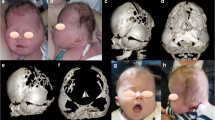Abstract
Purpose
Chiari 1 malformation (CM1) is a well-known association with complex craniosynostosis (CC), while it has been rarely reported in association with monosynostosis. The aim of the present study is to investigate on the association between CM1 and untreated sagittal synostosis (USS).
Method
The study included 48 cases of sagittal synostosis (SS), untreated for misdiagnosis and associated with CM1. The children were firstly diagnosed for CM1 by MRI (mean age 9) than for SS (mean age 10.5) by three-dimensional computerized tomography (3D-CT), which documented the absence of the sagittal suture, in the presence of residual indentation of all the other sutures. Syndromic cases were diagnosed by clinical evaluation and molecular studies.
Results
Of the 48 children harboring CM1 plus USS, 21 were asymptomatic for CM1 and are still on follow-up, while 27 children were operated for syringomyelia and scoliosis and/or occurrence of symptoms, three of them had an acute presentation (two papilledema and one sleep apneas) and 11 children had a documented increase of preoperative ICP. Craniovertebral decompression (CVD) was the first-line surgery in 24 children, 16 with duroplasty and five without and eight had also cerebellar (CBL) tonsil coagulation. A cranial vault remodelling was firstly performed in three children. Fifteen percent of children submitted to CVD needed a revision for cerebrospinal fluid (CSF) collection, while two needed both the supra- and infratentorial decompressive procedure and another two needed a treatment for the associated hydrocephalus.
Conclusions
The present study identified an USS in 27 (15.5%) of 174 CM1 children operated for a symptomatic CM1. We suggest to define this association CM1 plus USS, a new subtype of complex CM1. For the high percentage of complications and multiple procedures needed to solve the CM1, we advise to identify by 3D-CT scan these children before performing CVD. Our finding suggests also that, if left untreated, SS may lead to the delayed occurrence of a challenging subset of CM1.









Similar content being viewed by others
References
Al-Otibi M, Jea A, Kulkarni AV (2007) Detection of important venous collaterals by computed tomography venogram in multisutural synostosis. J Neurosurg 107:508–510
Al-Shaqsi SZ, Rai A, Forrest C, Phillips JJ (2019) Standardization of cranial index measurement in sagittal craniosynostosis. J Craniofacial Surg 30(2):366–369
Aydin S, Hanimoglu H, Tanriverdi T, Yentur E, Kaynar MY (2005) Chiari type I malformations in adults: a morphometric analysis of the posterior cranial fossa. Surg Neurol 64:237–241
Boltshauser E, Ludwig S, Dietrich F, Landolt MA (2003) Sagittal craniosynostosis: cognitive development, behaviour, and quality of life in unoperated children. Neuropeditrics 34:293–300
Chieffo D, Tamburrini G, Massimi L, Di Giovanni S, Giasanti C, Caldarelli M, Di Rocco C (2010) Long-term neuropsychological development in single-suture craniosynostosis treated early. J Neurosurg Pediatr 5:232–237
Cinalli G, Spennato P, Sainte-Rose C, Arnaud E, Aliberti F, Brunelle F (2005) Chiari malformation in craniosynostosis. Childs Nerv Syst 21:889–901
Da Costa AC, Vicki A, Savarirayan AR, Wrennall JA, Chong DK, Holmes AD, Greensmith AL, Meara JG (2012) Neurodevelopmental functioning of infants with untreated single-suture craniosynostosis during early infancy. Childs Nerv Syst 28:869–877
Davis AA, Zuccoli G, Haredy MM, Runkel L, Losee J, Pollack IF, Tamber MS, Tyler-Kabara E, Goldstein JA, Nischal KK (2019) The incidence of Chiari malformations in patients with isolated sagittal synostosis. Plast Reconstr Surg Glob Open 7(2):2090
Di Rocco C, Frassanito P, Massimi L, Peraio S (2011) Hydrocephalus and Chiari type I malformation. Childs Nerv Syst 27:1653–1664
Eide PK (2008) Comparison of simultaneous continuous intracranial pressure (ICP) signals from ICP sensors placed within the brain parenchyma and the epidural space. Med Eng Phys 30:34–40
Engel M, Castrillón-Oberndorfer G, Hoffmann J, Orakcioglu B, Rohde S, Seeberger R, Freudlsperger C (2012) Chiari malformation in nonsyndromal single craniosynostosis--much ado about nothing? Acta Neurochir 154(10):1803–1807
Fearon JA, Singh DJ, Beals SP, Yu JC (2007) The diagnosis and treatment of single-sutural synostoses: are computed tomographic scans necessary? Plast Reconstr Surg 120:1327–1331
Glass GE, O’Hara J, Canham N, Cillier SD, Dunaway D, Fenwick AL, Jeelani NO, Johnson D, Lester T, Lord H, JEV M, Nishikawa H, Noons P, Schwiebert K, Shipste C, Taylor-Beadling A, SRF T, Vasudevan P, Wall SA, AOM W, Wilson LC (2019) ERF-related craniosynostosis: the phenotypic and developmental profile of a new craniosynostosis syndrome. Am J Med Genet A 179(4):615–627
Goldstein JA, Paliga JT, Bailey RL, Heuer GG, Taylor JA (2013) Posterior vault distraction with midface distraction without osteotomy as a first stage for syndromic craniosynostosis. J Craniofac Surg. 24(4):1263–1267
Headache Classification Committee of the International Society (2013) The international classification of headache disorders 3rd edition (Beta version). Cephalalgia 33(9):629–808
Iida C, Sakamoto Y, Miwa T, Yoshida K, Kishi K (2019) Posterior distraction first or fronto-orbital advancement first for severe syndromic craniosynostosis. J Craniofac Surg 30(1):47–49
Jeevan DS, Anlsow P, Jayamohan J (2008) Abnormal venous drainage in syndromic craniosynostosis and the role of CT venography. Childs Nerv Syst 24:1413–1420
Kapp-Simon KA, Speltz ML, Cunningham ML, Patel PK, Tomita T (2007) Neurodevelopment of children with single suture craniosynostosis: a review. CNeS 23:269–281
Knight SJ, Anderson VA, Spencer-Smith MM, Da Costa AC (2014) Neurodevelopmental outcomes in infants and children with single-suture craniosynostosis: a systematic review. Dev Neuropsychol 39:159–186
Leikola J, Koljonen V, Valanne L, Hukki J (2010) The incidence of Chiari malformation in non-syndromic single suture craniosynostosis. Childs Nerv Syst 26:771–774
Lekovic GP, Bristol RE, Rekate HL (2004) Cognitive impact of craniosynostosis. Semin Pediatr Neurol 11:305–310
Mathijssen IM (2015) Guideline for care of patients with the diagnoses of craniosynostosis: working group on craniosynostosis. J Craniofac Surg 26:1735–1807
Pouratian N, Sansur CA, Newman SA, Jane JA Jr, Jane JA Sr (2007) Chiari malformations in patients with uncorrected sagittal synostosis. Surg Neurol 67:422–428
Rijken BF, Lequin MH, van der Lijn F, van Veelen-Vincent ML, de Rooi J, Hoogendam YY, Niessen WJ, Mathijssen IM (2015) The role of the posterior fossa in developing Chiari I malformation in children with craniosynostosis syndromes. J Craniomaxillofac Surg 43:813–819
Sakamoto Y, Miwa T, Nakajima H, Yoshida K, Kishi K (2016) A new technique for posterior distraction in craniosynostosis: the double-door technique. J Craniofac Surg 27(4):950–952
Sandberg DI, Navarro R, Blanch J, Ragheb J (2007) Anomalous venous drainage preventing safe posterior fossa decompression in patients with Chiari malformation type I and multisutural craniosynostosis. J Neurosurg 106:490–494
Shipster C, Hearst D, Somerville A, Stackhouse J, Hayward R, Wade A (2003) Speech, language, and cognitive development in children with isolated sagittal synostosis. Dev Med Child Neurol l45:34–43
Strahle J, Muraszko KM, Buchman SR, Kapurch J, Garton HJ, Maher CO (2011) Chiari malformation associated with craniosynostosis. Neurosurg Focus 31(3):E2
Thompson DN, Hayward RD, Harkness WJ, Bingham RM, Jones BM (1995) Lessons from a case of kleeblattscha. Case report. J Neurosurg 82:1071–1074
Valentini L, Visintini S, Saletti V, Chiapparini L, Estienne M, Solero CL (2011) Treatment for Chiari 1 malformation (CIM): analysis of a pediatric surgical series. Neurol Sci 32(Suppl 3):S321–S324
Author information
Authors and Affiliations
Corresponding author
Ethics declarations
Conflict of interest
On behalf of all authors, the corresponding author states that there is no conflict of interest.
Laura Valentini.
Additional information
Publisher’s note
Springer Nature remains neutral with regard to jurisdictional claims in published maps and institutional affiliations.
Rights and permissions
About this article
Cite this article
Valentini, L.G., Saletti, V., Erbetta, A. et al. Chiari 1 malformation and untreated sagittal synostosis: a new subset of complex Chiari?. Childs Nerv Syst 35, 1741–1753 (2019). https://doi.org/10.1007/s00381-019-04283-0
Received:
Accepted:
Published:
Issue Date:
DOI: https://doi.org/10.1007/s00381-019-04283-0




